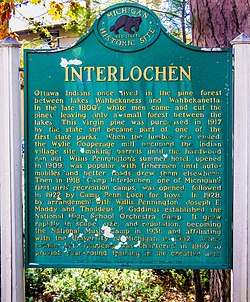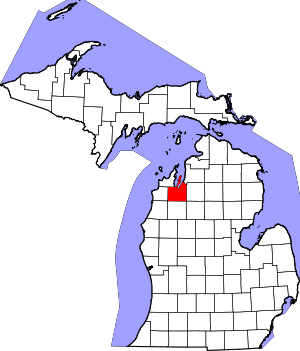Interlochen, Michigan
Interlochen, (formerly Interlaken and Wylie) is an unincorporated community and census-designated place (CDP) in Green Lake Township, Grand Traverse County, Michigan, United States. As of the 2010 census, the Interlochen census-designated place (CDP) had a population of 583.[2]
Interlochen, Michigan | |
|---|---|
 Interlochen Historical Marker | |
| Motto(s): Between the Lakes | |
| Coordinates: 44°38′43″N 85°46′02″W[1] | |
| Country | United States |
| State | Michigan |
| County | Grand Traverse |
| Township | Green Lake |
| Area | |
| • Total | 1.27 sq mi (3.29 km2) |
| • Land | 1.24 sq mi (3.21 km2) |
| • Water | 0.03 sq mi (0.08 km2) |
| Elevation | 840 ft (256 m) |
| Population | |
| • Total | 583 |
| • Density | 470/sq mi (181.5/km2) |
| Time zone | UTC-5 (Eastern (EST)) |
| • Summer (DST) | UTC-4 (EDT) |
| ZIP code(s) | 49643 |
| Area code(s) | 231 |
| GNIS feature ID | 629053[1] |
| FIPS code | 26-40800 |
.jpg)
The community is noted for the internationally renowned Interlochen Center for the Arts. This summer art camp and year-long artist residency draws young artists from around the world, and perfects their skills in visual arts, music, dance, acting, writing, and film.[3]
History
Interlochen takes its name from the Latin "inter", meaning "between", and the Scottish Gaelic "lochen", meaning lakes.
Before the arrival of European settlers, members of the Odawa people lived between the lakes they called Wahbekaness and Wahbekanetta (now named Duck Lake and Green Lake, respectively). Beginning in the late 19th century, European settlers began logging and fishing industries in the area, and founded the small village of Wylie, one mile south of present-day Interlochen. Because of logging, the Manistee and North-Eastern Railroad (owned by the Buckley and Douglas Lumber Company of Manistee) extended its line north from Nessen City and arrived between the lakes in the fall of 1889. Similarly, the Chicago and West Michigan Railway extended its line north from Baldwin on its way to Traverse City in 1890. The two lines crossed in current-day downtown Interlochen where a depot and interlocking tower were located. The original townsite, however, was platted just south of the depot along either side of the M&NE rail line in late 1889 or early 1890, with the business district centering on current M-137 and Riley Rd/10th Street.
As the lumber industry grew, the area became more deforested. However, it was predicted from the beginning that the area would become a popular summer resort, and so Buckley and Douglas set aside 186 acres of virgin pines between Duck and Green lakes for preservation. The result was Pine Park, a public retreat boasting virgin forests and pristine lakes. A small railroad depot named Pine Park Station was built. Visitors began flocking to the region during the warmer months to camp, fish, boat, and escape the heat of the crowded cities. Piggybacking on the vacation boom, local businessman Willis Pennington purchased land adjacent to Pine Park on the banks of Green Lake and opened the Pennington Hotel in 1909.[4]
In the mid-1910s, local representatives became worried that Pine Park would soon be logged off and so they lobbied the Michigan Legislature for help. The state ultimately allocated $60,000 in 1917 to purchase the property[5], and the newly acquired parkland was dedicated as The Pines, later renamed Interlochen State Park, the first state park organized by the state of Michigan (Mackinac Island was originally a national park before becoming Michigan's first state park in 1895).[6] In 1928, the National High School Orchestra Camp was founded at Interlochen and evolved to become Interlochen Center for the Arts, which includes a summer camp as well as a fine arts boarding high school and public radio station. The camp has expanded to both sides of M-137 (designated as a highway to the arts camp in 1930[7]), and enveloped the entire village of Wylie.
By the late 20th century, the railroads that brought students, vacationers, and lumber through Interlochen, had been removed. The north-south M&NE railroad was removed in 1934[8], and the west-east C&WM railroad (Pere Marquette Railway after 1899) removed in 1982.[9] The area remains a popular vacation spot, with hiking, fishing, camping, boating, swimming, cross country skiing, and snowmobiling the most popular activities.
Geography
As the name suggests, Interlochen is situated between the two lakes of the original Odawa settlement. It is 14 miles (23 km) southwest of Traverse City at 44°38′43″N 85°46′02″W, and sits at an elevation of 841 feet (256 m) above sea level. The ZIP Code is 49643.
Climate
Interlochen lies close to the 45th parallel north, approximately halfway between the equator and the north pole. It, therefore, experiences typical Northern Michigan weather: very cold in the winter, and very warm in the summer. Interlochen is close enough to Lake Michigan that it experiences heavy lake-effect snow, but not close enough to be cooled by the Great Lake's breeze, furthering the extremes of the winter and summer seasons. However, other lake-effect precipitation in the summer is also present, causing lush greenery and magnificent thunderstorms, and making Interlochen picturesque in the summer as well as in the winter.
Demographics
According to the census of 2010, there were 583 people, 240 households, and 142 families residing in the Interlochen CDP. The population density was 470.0 people per square mile (181.5/km2). There were 277 housing units at an average density of 223.3 per square mile (86.2/km2).[10]
As of the 2010 census, the racial makeup of the CDP was 52.2% White, 43.2% Native American, 0.5% African-American or Black, 0.2% Native Hawaiian or Pacific Islander, 0.2% some other race, and 1.7% from two or more races. 1.9% of the population were Hispanic or Latino, who can be of any race.[10]
In the CDP, the population was spread out with 25.4% under the age of 18, 8.9% from 18 to 24, 33.3% from 25 to 44, 24.0% from 45 to 64, and 8.4% who were 65 years of age or older. The median age was 32.3 years. For every 100 females, there were 104.6 males. For every 100 females age 18 and over, there were 98.6 males.[10]
Government
The Village of Interlochen is an unincorporated community and does not have its own local government, but is governed locally by Green Lake Township. The township offices are located in Interlochen.[11] Some governmental services are also provided by the county.
Media
Interlochen is home to 88.7 WIAA, which is run by the Interlochen Center for the Arts and operates as Northern Michigan's National Public Radio affiliate.
Transportation
.jpeg)
Highways


Public transportation
Interlochen is served by Traverse City's public transportation system, the Bay Area Transportation Authority (BATA) which serves most of the Grand Traverse region with dial-a-ride services. BATA debuted its first hybrid bus in December 2005. BATA recently completed a bus transfer terminal on Hall Street in Traverse City, which opened July 21, 2006. The terminal is used to transfer riders to different buses on different routes. BATA also links riders to the Greyhound terminal for regional and long-distance travel.
Given the long dirt and gravel roads that cover much of Interlochen and its surrounding area, in 2011, BATA began an experimental transit program consisting of rentable skateboards, scooters, bicycles and cross country skis (only available during the winter seasons). The program is largely targeted at the area's sizeable student population.
General aviation
Green Lake Airport (Y88) is located three miles south of Interlochen.
References
- "Interlochen". Geographic Names Information System. United States Geological Survey.
- "Geographic Identifiers: 2010 Demographic Profile Data (G001): Interlochen CDP, Michigan". American Factfinder. U.S. Census Bureau. Retrieved December 19, 2016.
- "Interlochen Center for the Arts". www.interlochen.org. Retrieved 2020-03-13.
- https://crescendo.interlochen.org/story/timber-tourism-how-conservation-shaped-interlochen-michigan. Missing or empty
|title=(help) - "DNR - Michigan's first state park". www.michigan.gov. Retrieved 2020-04-11.
- "History of Interlochen". Interlochen Center for the Arts. 2007. Archived from the original on 2007-10-15. Retrieved 2007-11-22.
- Michigan; State Highway Department; H.M. Gousha Company (1927), Official highway service map, The Dept., OCLC 79754957
- "michiganrailroads.com - Evolution Map - Lower - 1934". www.michiganrailroads.com. Retrieved 2020-03-13.
- "michiganrailroads.com - Evolution Map - Lower - 1982". www.michiganrailroads.com. Retrieved 2020-03-13.
- "Profile of General Population and Housing Characteristics: 2010 Demographic Profile Data (DP-1): Interlochen CDP, Michigan". American Factfinder. U.S. Census Bureau. Archived from the original on February 13, 2020. Retrieved December 19, 2016.
- "Green Lake Township Web Site". Green Lake Township Board. 2007. Retrieved 2007-11-22.

